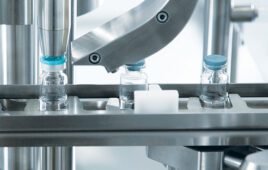
A paper pump, or ‘hydraulic battery,’ is shown here pumping fluid through a simple microchannel at a constant rate of 0.6 μl/min. Each snapshot is 12 min apart. The technology may be used to develop new technologies, such as portable diagnostic tools for use in the field. [Image courtesy Glenn Walker]
The inexpensive paper pump – developed by researchers at North Carolina State University and the University of North Carolina at Chapel Hill – uses capillary actions to power portable microfluidic devices, which control fluids of 1 ml or less volume.
“One longstanding challenge to the development of portable, real-world microfluidic device technologies has been the need to find a cost-effective way to pump fluids through the device when outside of the lab,” said Glenn Walker, co-corresponding author of the study and associate professor in the joint biomedical engineering program at NC State and UNC, in a press release. “Portability is important because it makes new applications possible, such as diagnostic tools that can be used in the field. Electric pumps, and tubing to connect them, are fine for a laboratory environment, but those aren’t easy to take with you.”
The paper pump can also start and stop the flow of fluids through microfluidic devices and it allows users to control the flow.
The researchers refer to their pump as a hydraulic battery, even though it uses no electricity to use. The battery aspect of the device is the power of pumping from the capillary action.
Capillary action is when liquid is drawn to narrow spaces without the use of external forces, much like a paper towel soaking up a liquid. The capillary action happens when the adhesion to the walls is stronger than cohesive forces within the liquid’s molecules, according to the U.S. Geological Survey.
“Our system uses pieces of paper that are 125 microns thick, little more than the width of a single hair,” Walker said. “Capillary action pulls a liquid into the paper. And by changing the shape of the paper, we are able to control how much liquid is pulled through an attached device – and how quickly that happens.”
The paper pumps can be 2D by cutting out the paper or 3D when stacking the pumps on top of each other.
“By stacking the paper we are able to create more complex flow profiles, depending on the needs for any given application,” Walker said. “And any one of these hydraulic battery pumps costs less than a dime.”
“Our hydraulic battery is small, lightweight, very inexpensive, easy to connect to a device and disposable,” Walker said. “In addition, our paper pumps could be saved for later evaluation, such as to run secondary, lab-based tests to confirm on-site diagnoses.”
This is new paper pump adds to a line of paper products that are meant to make it easier for researchers to carry an entire lab on their backs. Earlier this year, a Stanford bioengineer developed a human-powered centrifuge out of paper that costs less than 25 cents to make. It created centrifugal forces of 30,000 Gs and rotated at 125,000 rpms. The same bioengineer also developed a fully functional microscope to diagnose blood-borne diseases for just under a dollar.
Researchers on the paper pump have filed a patent application for the technology and are looking for industry partners to bring it to the marketplace.
“We’re optimistic that is could make a difference in both public health and advancing fundamental research,” said Walker.
The study was published online in the journal Technology and was supported by the NC State University Chancellor’s Innovation Fund.
[Want to stay more on top of MDO content? Subscribe to our weekly e-newsletter.]




